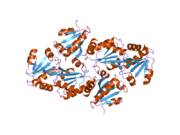
TXN2
| TXN2 | |||||||||||||||||||||||||||||||||||||||||||||||||||
|---|---|---|---|---|---|---|---|---|---|---|---|---|---|---|---|---|---|---|---|---|---|---|---|---|---|---|---|---|---|---|---|---|---|---|---|---|---|---|---|---|---|---|---|---|---|---|---|---|---|---|---|
 | |||||||||||||||||||||||||||||||||||||||||||||||||||
| |||||||||||||||||||||||||||||||||||||||||||||||||||
| Identifiers | |||||||||||||||||||||||||||||||||||||||||||||||||||
| Aliases | TXN2, MT-TRX, MTRX, TRX2, COXPD29, thioredoxin 2, TXN | ||||||||||||||||||||||||||||||||||||||||||||||||||
| External IDs | OMIM: 609063 MGI: 1929468 HomoloGene: 40849 GeneCards: TXN2 | ||||||||||||||||||||||||||||||||||||||||||||||||||
| |||||||||||||||||||||||||||||||||||||||||||||||||||
| |||||||||||||||||||||||||||||||||||||||||||||||||||
| |||||||||||||||||||||||||||||||||||||||||||||||||||
| |||||||||||||||||||||||||||||||||||||||||||||||||||
| Wikidata | |||||||||||||||||||||||||||||||||||||||||||||||||||
| |||||||||||||||||||||||||||||||||||||||||||||||||||
Thioredoxin, mitochondrial also known as thioredoxin-2 is a protein that in humans is encoded by the TXN2 gene on chromosome 22. This nuclear gene encodes a mitochondrial member of the thioredoxin family, a group of small multifunctional redox-active proteins. The encoded protein may play important roles in the regulation of the mitochondrial membrane potential and in protection against oxidant-induced apoptosis.
Structure
As a thioredoxin, TXN2 is a 12-kDa protein characterized by the redox active site Trp-Cys-Gly-Pro-Cys. In its oxidized (inactive) form, the two cysteines form a disulfide bond. This bond is then reduced by thioredoxin reductase and NADPH to a dithiol, which serves as a disulfide reductase. In contrast to TXN1, TXN2 contains a putative N-terminal mitochondrial targeting sequence, responsible for its mitochondria localization, and lacks structural cysteines. Two mRNA transcripts of the TXN2 gene differ by ~330 bp in the length of the 3′-untranslated region, and both are believed to exist in vivo.
Function
This nuclear gene encodes a mitochondrial member of the thioredoxin family, a group of small multifunctional redox-active proteins. The encoded protein is ubiquitously expressed in all prokaryotic and eukaryotic organisms, but demonstrates especially high expression in tissues with heavy metabolic activity, including the stomach, testis, ovary, liver, heart, neurons, and adrenal gland. It may play important roles in the regulation of the mitochondrial membrane potential and in protection against oxidant-induced apoptosis. Specifically, the ability of TXN2 to reduce disulfide bonds enables the protein to regulate mitochondrial redox and, thus, the production of reactive oxygen species (ROS). By extension, downregulation of TXN2 can lead to increased ROS generation and cell death. The antiapoptotic function of TXN2 is attributed to its involvement in GSH-dependent mechanisms to scavenge ROS, or its interaction with, and thus regulation of, thiols in the mitochondrial permeability transition pore component adenine nucleotide translocator (ANT).
Overexpression of TXN2 was shown to have attenuated hypoxia-induced HIF-1alpha accumulation, which is in direct opposition of the cytosolic TXN1, which enhanced HIF-1alpha levels. Moreover, although both TXN2 and TXN1 are able to reduce insulin, TXN2 does not depend on the oxidative status of the protein for this activity, a quality which may contribute to their difference in function.
Clinical Significance
It has been demonstrated that genetic polymorphisms in the TXN2 gene may be associated with the risk of spina bifida.
TXN2 is known to inhibit transforming growth factor (TGF)-β-stimulated ROS generation independent of Smad signaling. TGF-β is a pro-oncogenic cytokine that induces epithelial–mesenchymal transition (EMT), which is a crucial event in metastatic progression. In particular, TXN2 inhibits TGF-β-mediated induction of HMGA2, a central EMT mediator, and fibronectin, an EMT marker.
Interactions
TXN2 is shown to interact with ANT.
Further reading
- Wang Z, Zhang H, Li XF, Le XC (2007). "Study of interactions between arsenicals and thioredoxins (human and E. coli) using mass spectrometry". Rapid Communications in Mass Spectrometry. 21 (22): 3658–66. Bibcode:2007RCMS...21.3658W. doi:10.1002/rcm.3263. PMID 17939155.
- Udler M, Maia AT, Cebrian A, Brown C, Greenberg D, Shah M, Caldas C, Dunning A, Easton D, Ponder B, Pharoah P (Jul 2007). "Common germline genetic variation in antioxidant defense genes and survival after diagnosis of breast cancer". Journal of Clinical Oncology. 25 (21): 3015–23. doi:10.1200/JCO.2006.10.0099. PMID 17634480.
- Zhang H, Go YM, Jones DP (Sep 2007). "Mitochondrial thioredoxin-2/peroxiredoxin-3 system functions in parallel with mitochondrial GSH system in protection against oxidative stress". Archives of Biochemistry and Biophysics. 465 (1): 119–26. doi:10.1016/j.abb.2007.05.001. PMID 17548047.
- Oestergaard MZ, Tyrer J, Cebrian A, Shah M, Dunning AM, Ponder BA, Easton DF, Pharoah PD (Aug 2006). "Interactions between genes involved in the antioxidant defence system and breast cancer risk". British Journal of Cancer. 95 (4): 525–31. doi:10.1038/sj.bjc.6603272. PMC 2360671. PMID 16868544.
- Cebrian A, Pharoah PD, Ahmed S, Smith PL, Luccarini C, Luben R, Redman K, Munday H, Easton DF, Dunning AM, Ponder BA (Jan 2006). "Tagging single-nucleotide polymorphisms in antioxidant defense enzymes and susceptibility to breast cancer". Cancer Research. 66 (2): 1225–33. doi:10.1158/0008-5472.CAN-05-1857. PMID 16424062.
- Collins JE, Wright CL, Edwards CA, Davis MP, Grinham JA, Cole CG, Goward ME, Aguado B, Mallya M, Mokrab Y, Huckle EJ, Beare DM, Dunham I (2005). "A genome annotation-driven approach to cloning the human ORFeome". Genome Biology. 5 (10): R84. doi:10.1186/gb-2004-5-10-r84. PMC 545604. PMID 15461802.
- Damdimopoulos AE, Miranda-Vizuete A, Pelto-Huikko M, Gustafsson JA, Spyrou G (Sep 2002). "Human mitochondrial thioredoxin. Involvement in mitochondrial membrane potential and cell death". The Journal of Biological Chemistry. 277 (36): 33249–57. doi:10.1074/jbc.M203036200. PMID 12080052.
- Chen Y, Cai J, Murphy TJ, Jones DP (Sep 2002). "Overexpressed human mitochondrial thioredoxin confers resistance to oxidant-induced apoptosis in human osteosarcoma cells". The Journal of Biological Chemistry. 277 (36): 33242–8. doi:10.1074/jbc.M202026200. PMID 12032145.






